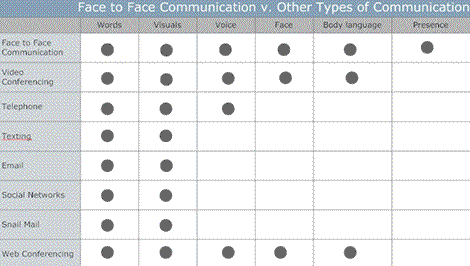- POPULAR ARTICLES
- Thank You Words
- Retirement Wishes
- Face to Face
Face to Face Communication
Conventional wisdom tells us that face to face communication is more effective than other types of communication such as telephone or email.
The argument in favor of face time is that telephone or email communication lacks important nonverbal cues to help us understand the message.
What are those nonverbal cues and how important they are in communication?.
The importance of nonverbal communication
There have been several studies aimed at trying to determine how much influence nonverbal cues have on getting the message. Unfortunately, each study has been done within a very specific context, and no single study provides the complete picture of how much nonverbal cues influence communication.
Even though we lack an all encompassing nonverbal communication study, all the individual studies point to a common finding. Nonverbal cues play a significant role in understanding a verbal message. Nonverbal communication either confirms or contradicts verbal messages.
As people continue to increase their use of cell phones, email and texting, what's happening to communication?
Comparing Types of Communication
The chart below shows a comparison of face to face communication with other types of communication. Each column depicts a category of message cues as follows:Words, the words that are spoken or written to convey the message.
Visuals. The visual aids (pictures, videos, and charts)that help understand the message.
Voice. The tone, inflection, and volume of the voice used to deliver the message.
Face. The facial expressions such as smiles, frowns, raised eyebrows, pouts, and all the gestures we make with our face while delivering a message.
Body Language. The position and movement of the arms, shoulders, legs, head and other body language.
Presence. This includes all the conditions of the room or shared space that may affect the communication. Noise, likes and dislikes for a person in the room, proximity to other people in the room, temperature, smells, what others are doing while the communication is taking place.

In this chart you can see why communication effectiveness may decline as fewer cues are available to help understand what is being said.
Let's look at each type of communication in more detail. In face to face communication, we have all the cues available to us: words, facial expression, gestures, body language, tone of voice, room temperature, room noise, and other people in the room that might be present. If there is something missing in the person's words, there are other cues that will complement the message, if they are congruent with the words. The message will be more complete and clear when all cues are present.
Videoconferencing and web conferencing are almost as effective as face to face communication. The only cue that is missing in video and web conferencing is the shared presence or surroundings that may give people additional information about the message meaning.
Telephone communication lacks nonverbal cues. When we are having a phone conversation, we don't have facial expressions or body language to help us decode messages, so we must focus on every word being said, and the tone of voice that is being used. We compensate for the absence of nonverbal cues by adding more weigh to the words being said and the tone of voice being used.
The remaining types of communication on the chart are missing both, tone of voice as well as nonverbal communication. They only use words and visuals. Does that mean that the quality of the communication is minimal? Not necessarily, it means that the words and visuals carry all the weight to ensure a message is clearly understood.
Texting or Instant Messaging Communication. When we text each other using a phone or a PDA, we only have words to send our message and to receive it. We are missing tone of voice, facial expressions, body language and presence to help us decode the message. To complicate matters, when we text we use shorthand (e.g. LOL for laughing out loud). We also misspell or shorten words because we don't want to use a tiny thumboard to write long messages, and because we're in a rush to send the messages out. After all, it’s instant messaging.
Email. Email is equivalent to texting, with an added disadvantage: In email communication there is a delay in between messages being sent, received and replied to. This prevents a solid thread in the conversation from forming. When someone sends you an email, they are in a frame of mind that may or may not be the same later, when you read and reply to their email. Your reply is now floating in a different time, it may link to the original message or it may be irrelevant. The same applies to your reply, there may be a delay between the time you send it and the time the other person reads it.
Postal (Snail) Mail is very similar to email communication, with an added disadvantage. The message takes longer to reach its intended recipient. In addition, snail mail is less convenient to write and send. Now you have paper, pens, envelopes and stamps to find. You may write less often.
Traditional mail has a subjective value over email. People think of traditional mail as more personal when compared to email. Seeing the person’s scribbling on the page is endearing and personal. You recognize the writing, you know the sender took the time to write you, so you may hang on to every word with more attention than ever.
In conclusion
When face to face communication is not possible, we try to compensate by giving added weight to whatever cues are available to us at the moment; we settle.
We also compensate by using symbols as nonverbal cues. We try to replace our facial expression by adding emoticons (emotion faces) to our texts and emails. We try to add tone of voice to emails by capitalizing when we want to yell, or we try using color, bold and italics so we can emphasize our words. We create avatars to represent us, some look like us and some don't. Some are even animated.
And yet, we can't fully replace face to face communication. No smiley face can replace the warmth conveyed by the smiling eyes of a loved one; no cartoon red face can show the genuine embarrassment we show when we blush, no amount of LOLs can tell us when someone is having a belly laughter with tears in his eyes.
Face to face communication still remains the best and most complete way of getting our message across.
Read related articles in this section: Technology and Human Communication
Or visit www.doitinperson.com to read more about the pluses of face time.




